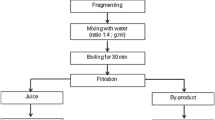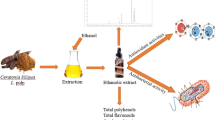Abstract
Carob molasses is widely consumed in many Mediterranean countries, including Tunisia where it is known as ‘Rub El Kharroub’. The main objective of the present study was to evaluate the physicochemical properties and biological activities of both commercial and homemade Tunisian carob molasses. The physicochemical characterization revealed that the main parameters (color and HMF concentration) were related to non-enzymatic browning reactions occurring during juice concentration. The phytochemical analysis proved that the presence of bioactive compounds (volatile compounds, phenolic substances and products of non-enzymatic browning reactions) in carob molasses samples justify their biological effects (antioxidant and antibacterial activities). Accordingly, such characteristics may qualify Tunisian carob molasses (both homemade and commercial) as nutritious and healthy food that could be directly consumed or used a functional ingredient in food and pharmaceutical industry.
Similar content being viewed by others
References
K. Dhaouadi, M. Belkhir, I. Akinocho, F. Raboudi, D. Pamies, E. Barrajón, C. Estevan, S. Fattouch, Sucrose supplementation during traditional carob syrup processing affected its chemical characteristics and biological activities. Food Sci. Technol. 57, 1–8 (2014)
L. Tounsi, S. Karra, H. Kechaou, N. Kechaou, Processing, physico-chemical and functional properties of carob molasses and powders. J. Food Meas. Charact. 11, 1440–1448 (2017)
O.B. Karaca, I.B. Saydam, M. Güven, Physicochemical, mineral and sensory properties of set-type yoghurts produced by addition of grape, mulberry and carob molasses (Pekmez) at different ratios. Int. J. Dairy Technol. 65, 111–117 (2012)
F. Abbès, W. Kchaou, C. Blecker, M. Ongena, G. Lognay, H. Attia, S. Besbes, Effect of processing conditions on phenolic compounds and antioxidant properties of date syrup. Ind. Crops Prod. 44, 634–642 (2013)
K. Dhaouadi, F. Raboudi, C. Estevan, E. Barrajon, E. Vilanova, M. Hamdaoui, S. Fattouch, Cell viability effects and antioxidant and antimicrobial activities of Tunisian date syrup (Rub El Tamer) polyphenolic extracts. J. Agric. Food Chem. 59, 402–406 (2011)
K. Dhaouadi, F. Raboudi, L. Funez-Gomez, D. Pamies, C. Estevan, M. Hamdaoui, S. Fattouch, Polyphenolic extract of barbary-fig (Opuntia ficus-indica) syrup: RP-HPLC-ESI-MS analysis and determination of antioxidant, antimicrobial and cancer-cells cytotoxic potentials. Food Anal. Methods 6, 45–53 (2013)
B.S. Wang, L.W. Chang, Z.C. Kang, H.L. Chu, H.M. Tai, M.H. Huang, Inhibitory effects of molasses on mutation and nitric oxide production. Food Chem. 126, 1102–1107 (2011)
M. Sengül, M.F. Ertugay, M. Sengül, Y. Yüksel, Rheological characteristics of carob Pekmez. Int. J. Food Prop. 10, 39–46 (2007)
H. Vaikousi, K. Koutsoumanis, C.G. Biliaderis, Kinetic modelling of non-enzymatic browning of apple juice concentrates differing in water activity under isothermal and dynamic heating conditions. Food Chem. 107, 785–796 (2008)
S. Benjakul, W. Visessanguan, V. Phongkanpai, M. Tanaka, Antioxidative activity of caramelisation products and their preventive effect on lipid oxidation in fish mince. Food Chem. 90, 231–239 (2005)
J.A. Rufián-Henares, F.J. Morales, Functional properties of melanoidins: In vitro antioxidant, antimicrobial and antihypertensive activities. Food Res. Int. 40, 995–1002 (2007)
L. Tounsi, N. Kechaou, Le caroubier (Ceratonia siliqua L.) et ses fruits: descriptions, intérêts et applications (Éditions Universitaires Européennes, Sarrebruck, 2017)
M.M. Özcan, D. Arslan, H. Gökçalik, Some compositional properties and mineral contents of carob (Ceratonia siliqua) fruit, flour and syrup. Int. J. Food Sci. Nutr. 58, 652–658 (2007)
A. Şimşek, N. Artik, Studies of composition of concentrates from different fruit. GIDA 27, 459–467 (2002)
N. Tetik, İ. Turhan, M. Karhan, H.R. Öziyci, Characterization of, and 5-hydroxymethylfurfural concentration in carob Pekmez. GIDA 35, 417–422 (2010)
N. Tetik, I. Turhan, H.R. Oziyci, M. Karhan, Determination of d-pinitol in carob syrup. Int. J. Food Sci. Nutr. 62, 572–576 (2011)
O.S. Toker, M. Dogan, N.B. Ersöz, M.T. Yilmaz, Optimization of the content of 5-hydroxymethylfurfural (HMF) formed in some molasses types: HPLC-DAD analysis to determine effect of different storage time and temperature levels. Ind. Crop. Prod. 50, 137–144 (2013)
CIE, Colorimetry, Supplement No. 2, Publication No. 15. (Commision International de l’Eclairage, Paris, France, 1986)
AFNOR, Jus de fruits et de légumes - Détermination de l’acidité titrable. NF EN 12147. (Association Française de Normalisation, Paris, France, 1997)
N. Turkmen, F. Sari, E.S. Poyrazoglu, Y.S. Velioglu, Effects of prolonged heating on antioxidant activity and colour of honey. Food Chem. 95, 653–657 (2006)
A.E. Cohen, Y. Birk, C. Mannheim, I. Saguy, A rapid method to monitor quality of apple juice during thermal processing. Food Sci. Technol. 31, 612–616 (1998)
A. Orphanides, V. Goulas, M. Chrysostomou, V. Gekas, Recovery of essential oils from carobs through various extraction methods, in Recent Advances in Environment, Energy Systems and Naval Science (2011), pp. 219–224
M. Dubois, K.A. Gilles, J.K. Hamilton, P.A. Rebers, F. Smith, Colorimetric method for determination of sugars and related substances. Anal. Chem. 28, 350–356 (1956)
G.L. Miller, Use of dinitrosalicylic acid reagent for determination of reducing sugar. Anal. Chem. 31, 426–428 (1959)
AOAC, Official Methods of Analysis, 17th edn. (Association of Official Analytical Chemists, Washington, DC, 2000)
L.Y. Chew, K.N. Prasad, I. Amin, A. Azrina, C.Y. Lau, Nutritional composition and antioxidant properties of Canarium odontophyllum Miq. (dabai) fruits. J. Food Compos. Anal. 24, 670–677 (2011)
AFNOR, Jus de fruits et de légumes - Dosage des minéraux par spectrométrie d’absorption atomique. NF V76-117. (Association Française de Normalisation, Paris, France, 1994)
R.E. Kitson, M.G. Mellon, Colorimetric determination of phosphorus as molybdivanadophosphoric acid. Ind. Eng. Chem. Anal. Ed. 16, 379–383 (1944)
V.L. Singleton, J.A. Rossi, Colorimetry of total phenolics with phosphomolybdic-phosphotungstic acid reagents. Am. J. Enol. Vitic. 16, 144–158 (1965)
R. Avallone, M. Plessi, M. Baraldi, A. Monzani, Determination of chemical composition of carob (Ceratonia siliqua): protein, fat, carbohydrates, and tannins. J. Food Compos. Anal. 10, 166–172 (1997)
P. Prieto, M. Pineda, M. Aguilar, Spectrophotometric quantitation of antioxidant capacity through the formation of a phosphomolybdenum complex: specific application to the determination of vitamin E. Anal. Biochem. 269, 337–341 (1999)
P. Bersuder, M. Hole, G. Smith, Antioxidants from a heated histidine-glucose model system. I: Investigation of the antioxidant role of histidine and isolation of antioxidants by high-performance liquid chromatography. J. Am. Oil Chem. Soc. 75, 181–187 (1998)
A. Yildirim, A. Mavi, A.A. Kara, Determination of Antioxidant and Antimicrobial activities of Rumex crispus L. Extracts. J. Agric. Food Chem. 49, 4083–4089 (2001)
D. A. Van den Berghe, A. J. Vlietinck, Screening methods for antibacterial and antiviral agents from higher plants. in Methods in Plant Biochemistry. (Academic Press, London, 1991), pp. 47–69
A.S. Karaman, A. Kayacier, Effect of temperature on rheological characteristics of molasses: modeling of apparent viscosity using adaptive neuro-fuzzy inference system (ANFIS). Food Sci. Technol. 44, 1717–1725 (2011)
A. Guilherme, T.L. Honorato, A.S. Dornelles, G.A.S. Pinto, E.S. Brito, S. Rodrigues, Quality evaluation of mesquite (Prosopis juliflora) pods and cashew (Anacardium occidentale) apple syrups. J. Food Process Eng. 32, 606–622 (2009)
IEC, Multimedia systems and equipment: colour measurement and management, International Standard 61966-2-1. (International Electrotechnical Commission, Geneva, Switzerland, 1999)
M. Akbulut, H. Coklar, G. Ozen, Rheological characteristics of Juniperus drupacea fruit juice (Pekmez) concentrated by boiling. Food Sci. Technol. Int. 14, 321–328 (2008)
Codex Alimentarius, List of codex specifications for food additives, CAC/MISC 6-2013 (2013)
A. Dehpour, B. Babakhani, S. Khazaei, M. Asadi, Chemical composition of essential oil and antibacterial activity of extracts from flower of Allium atroviolaceum. J. Med. Plants Res. 5, 3667–3672 (2011)
A. Djilani, A. Dicko, The therapeutic benefits of essential oils, in Nutrition, Well-Being and Health. (InTech, New York, 2012), pp. 155–178
M.M. Raj, H.V. Patel, L.M. Raj, N.K. Patel, Synthesis, characterization and in-vitro antimicrobial evaluation of some novel isoxazoline derivatives. Int. J. Res. Pharm. Chem. 3, 612–618 (2013)
A. Ben Hsouna, M. Trigui, R. Ben Mansour, R.M. Jarraya, M. Damak, S. Jaoua, Chemical composition, cytotoxicity effect and antimicrobial activity of Ceratonia siliqua essential oil with preservative effects against Listeria inoculated in minced beef meat. Int. J. Food Microbiol. 148, 66–72 (2011)
M.J. Cantalejo, Effects of roasting temperature on the aroma components of carob (Ceratonia siliqua L.). J. Agric. Food Chem. 45, 1345–1350 (1997)
M.A. Farag, D.M. El-Kersh, Volatiles profiling in Ceratonia siliqua (Carob bean) from Egypt and in response to roasting as analyzed via solid-phase microextraction coupled to chemometrics. J. Adv. Res. 8, 379–385 (2017)
G. Macleod, M. Forcen, Analysis of volatile components derived from the carob. Phytochemistry 31, 3113–3119 (1992)
M.E. Wakefield, G.P. Bryning, L.E. Collins, J. Chambers, Identification of attractive components of carob volatiles for the foreign grain beetle, Ahasverus advena (Waltl) (Coleoptera: Cucujidae). J. Stored Prod. Res. 41, 239–253 (2005)
M. Papagiannopoulos, H. R. Wollseifen, A. Mellenthin, B. Haber, R. Galensa, Identification and quantification of polyphenols in carob fruits (Ceratonia siliqua) and derived products by HPLC-UV-ESI/MS. J. Agric. Food Chem. 52, 3784–3791 (2004)
F. Abbès, M.A. Bouaziz, C. Blecker, M. Masmoudi, H. Attia, S. Besbes, Date syrup: effect of hydrolytic enzymes (pectinase/cellulase) on physico-chemical characteristics, sensory and functional properties. Food Sci. Technol. 44, 1827–1834 (2011)
E.I. Oikeh, E.S. Omoregie, F.E. Oviasogie, K. Oriakhi, Phytochemical, antimicrobial, and antioxidant activities of different citrus juice concentrates. Food Sci. Nutr. 4, 103–109 (2016)
S.L. Chen, D.J. Yang, H.Y. Chen, S.C. Liu, Effect of hot acidic fructose solution on caramelisation intermediates including colour, hydroxymethylfurfural and antioxidative activity changes. Food Chem. 114, 582–588 (2009)
G. Hwang, H.Y. Kim, K.S. Woo, J. Lee, H.S. Jeong, Biological activities of Maillard reaction products (MRPs) in a sugar-amino acid model system. Food Chem. 126, 221–227 (2011)
M.I. Halpin-Dohnalek, E.H. Marth, Staphylococcus aureus: production of extracellular compounds and behavior in foods—a review. J. Food Prot. 52, 267–282 (1989)
Acknowledgements
The authors would like to thank the industry “Confiserie Triki-le Moulin” (Sfax, Tunisia) for the financial support and analytical assistance. The authors are also grateful to all the Tunisian families (Bekalta, Monastir) for providing kindly carob molasses samples and explaining their manufacturing process.
Author information
Authors and Affiliations
Corresponding author
Ethics declarations
Conflict of interest
The authors declare that they have no conflict of interest.
Additional information
Publisher's Note
Springer Nature remains neutral with regard to jurisdictional claims in published maps and institutional affiliations.
Rights and permissions
About this article
Cite this article
Tounsi, L., Ghazala, I. & Kechaou, N. Physicochemical and phytochemical properties of Tunisian carob molasses. Food Measure 14, 20–30 (2020). https://doi.org/10.1007/s11694-019-00263-9
Received:
Accepted:
Published:
Issue Date:
DOI: https://doi.org/10.1007/s11694-019-00263-9




